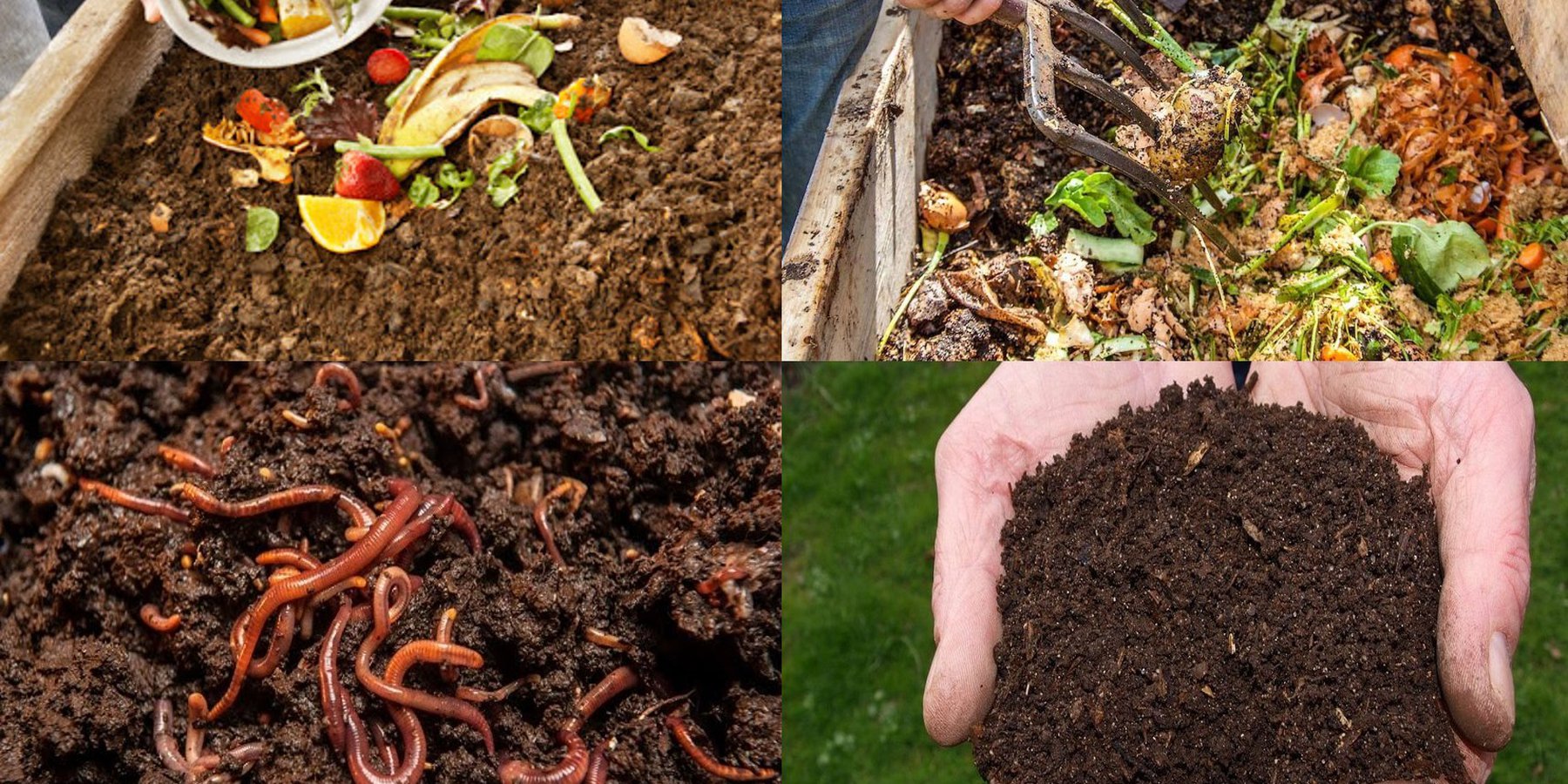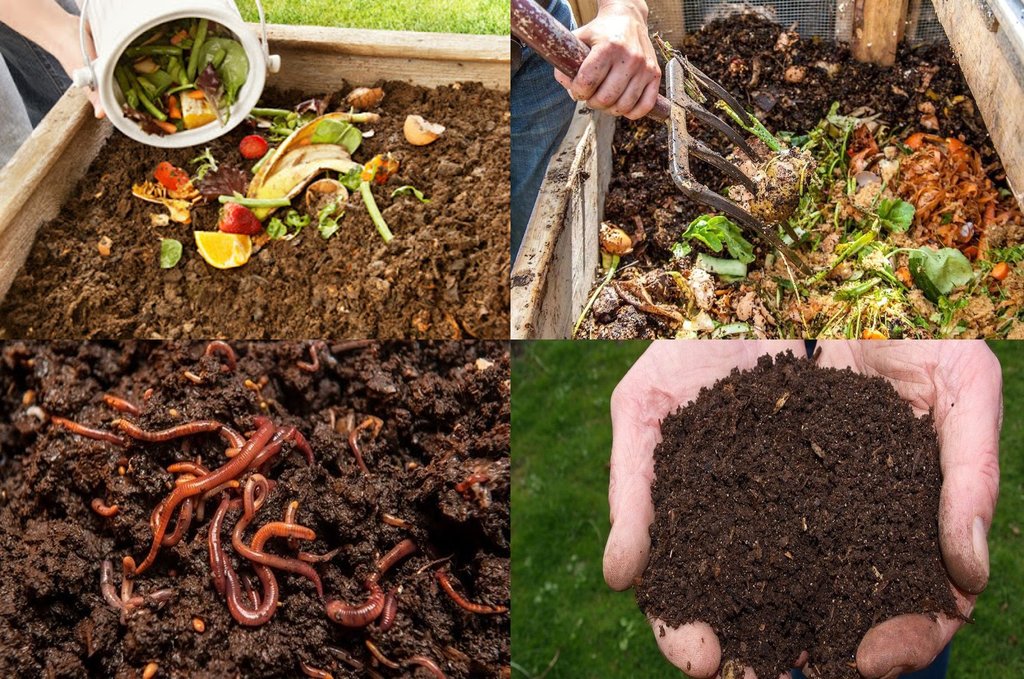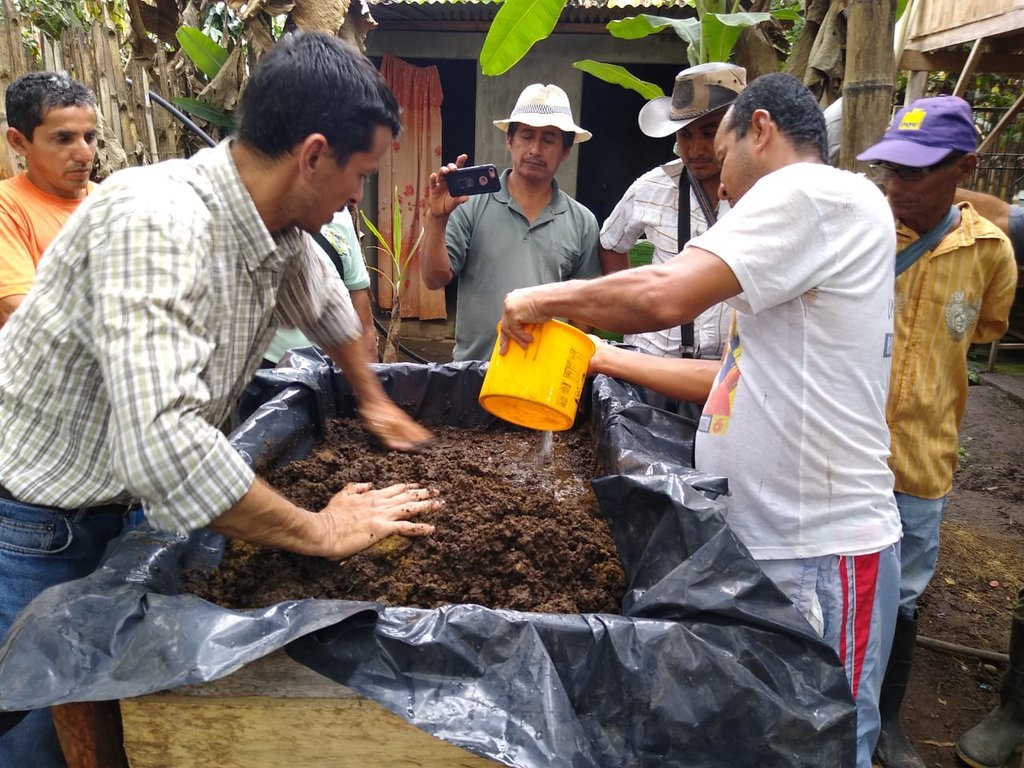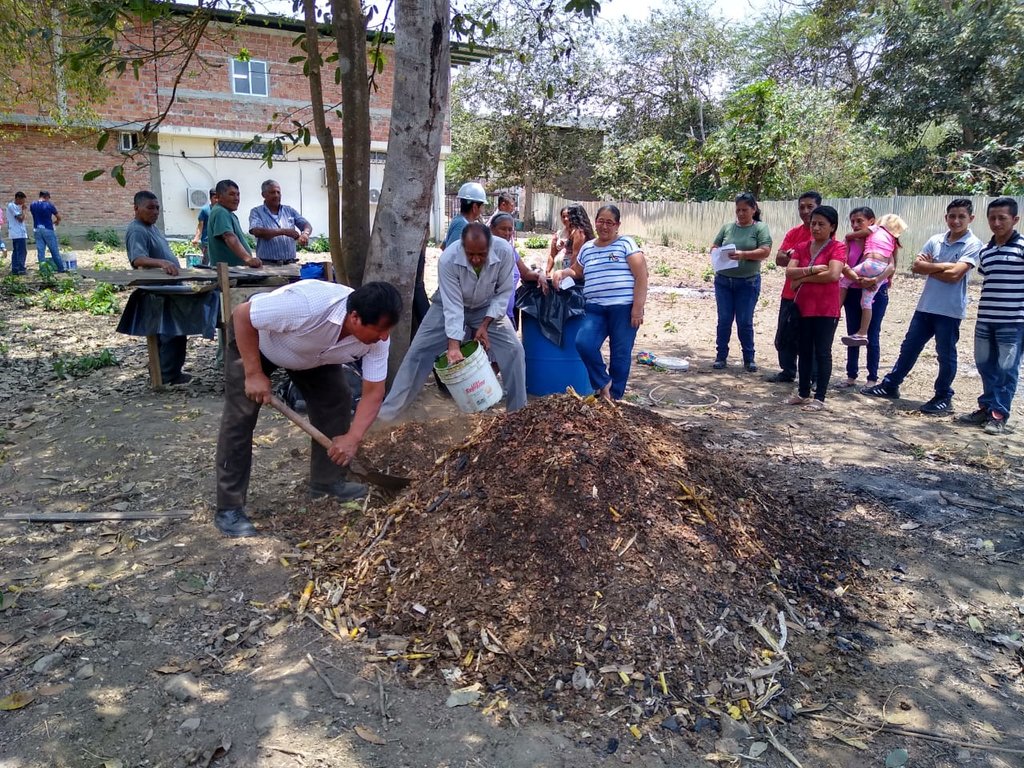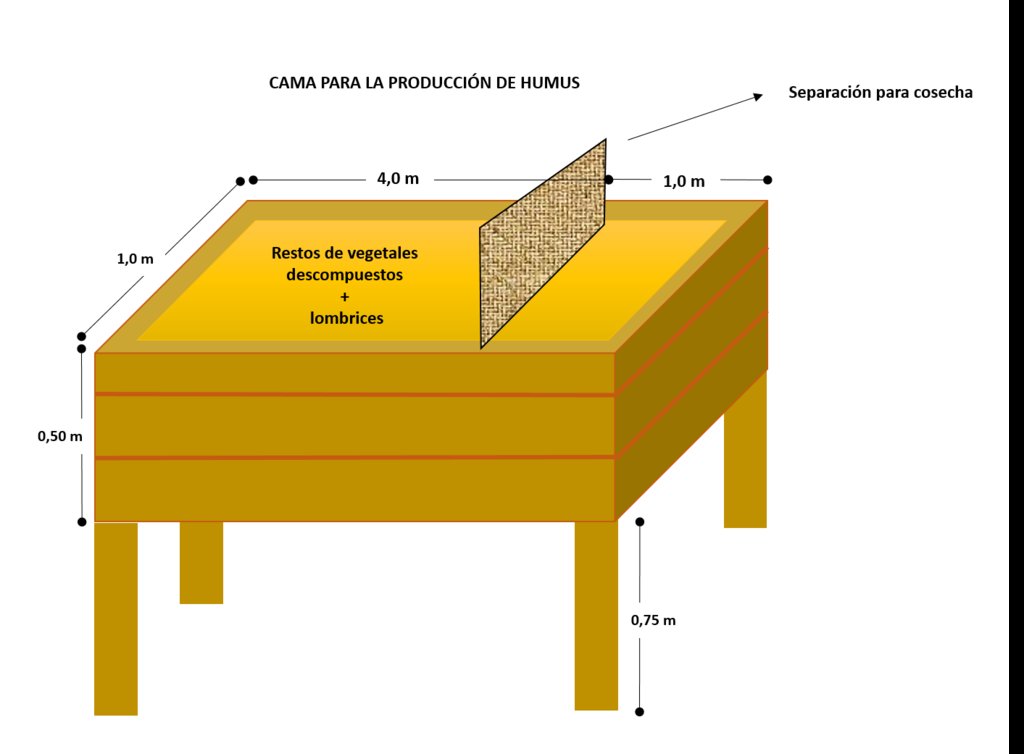Lombricultura [Ecuador]
- Creation:
- Update:
- Compiler: Pablo Caza
- Editor: Carlos Samaniego
- Reviewers: Giacomo Morelli, Nicole Harari, Johanna Jacobi
Abono orgánico, abono natural, tierra para sembrado, tierra sana, líquidos natrurales.
technologies_3270 - Ecuador
View sections
Expand all Collapse all1. General information
1.2 Contact details of resource persons and institutions involved in the assessment and documentation of the Technology
Key resource person(s)
SLM specialist:
Páez Martín
+593 99 222 5337
mpaezregion4@gmail.com
Organización de la Naciones Unidad para la Alimentación y la Agricultura
Ecuador
Name of project which facilitated the documentation/ evaluation of the Technology (if relevant)
Decision Support for Mainstreaming and Scaling out Sustainable Land Management (GEF-FAO / DS-SLM)Name of the institution(s) which facilitated the documentation/ evaluation of the Technology (if relevant)
Ministerio de Ambiente y Agua Ecuador (MAAE) - EcuadorName of the institution(s) which facilitated the documentation/ evaluation of the Technology (if relevant)
Ministerio de Agricultura y Ganadería Ecuador (MAG) - EcuadorName of the institution(s) which facilitated the documentation/ evaluation of the Technology (if relevant)
Organización de la Naciones Unidas para la Alimentación y la Agricultura Ecuador (FAO Ecuador) - Ecuador1.3 Conditions regarding the use of data documented through WOCAT
When were the data compiled (in the field)?
25/09/2019
The compiler and key resource person(s) accept the conditions regarding the use of data documented through WOCAT:
Yes
1.4 Declaration on sustainability of the described Technology
Is the Technology described here problematic with regard to land degradation, so that it cannot be declared a sustainable land management technology?
No
Comments:
Esta tecnología es de vital importancia para la conservación del suelo y la seguridad alimentaria de las familias.
2. Description of the SLM Technology
2.1 Short description of the Technology
Definition of the Technology:
Tecnología que consiste en la transformación de los desechos (residuos) orgánicos (estiércol, restos de plantas, etc) en humus, mediante la cría intensiva de lombriz de tierra y la actividad natural de microorganismos. Con esta técnica se genera humus orgánico solido o líquido que sirve para la producción agroecológica u orgánica de cultivos de ciclo corto o perenne.
2.2 Detailed description of the Technology
Description:
La lombricultura es la crianza y manejo de lombrices de tierra en condiciones de cautiverio con la finalidad básica de obtener con ella productos de mucha importancia para el hombre como lo es el lombricompost (humus o fertilizante natural de uso agrícola). Esta tecnología es aplicada por los agricultores para generar abonos orgánicos para la producción agroecológica de especies vegetales que se encuentran dentro en sus huertos familiares o en grades extensiones de cultivos. La técnica consiste en utilizar todo residuo orgánico generado en el hogar y sus alrededores el cual se debe compostar junto con las lombrices (californiana); la lombriz, mediante su aparato digestivo, transforma la materia sólida en una extraordinaria fuente fertilizadora. Los beneficios de la lombricultura son: recicla los desechos orgánicos de cada núcleo familiar hasta en un 60%, es una actividad con muy bajo costo de iniciación, se incentiva a la producción orgánica de cultivos, mejora los temas de seguridad alimentaria, entro otras. Los agricultores gustan de esta tecnología porque les permite generar abono orgánico de muy buena calidad a bajo costo, el cual es incorporado a las plantas para una producción limpia libre de contaminantes.
2.3 Photos of the Technology
General remarks regarding photos:
Estas fotos fueron seleccionadas de las actividades realizadas en las capacitaciones impartidas a productores de la provincia de Manabí durante la implementación de medidas en el Proyecto de Manejo Sostenible de la Tiera (MST) - MAAE-FAO – Ecuador
2.4 Videos of the Technology
Comments, short description:
https://vimeo.com/443259618
Location:
Parroquia de Membrillal, Cantón de Jipijapa, provincia de Manabí, Ecuador
Name of videographer:
Martín Paez, Técnico del proyecto de Manejo Sostenible de la Tiera (MST) - MAAE-FAO – Ecuador
2.5 Country/ region/ locations where the Technology has been applied and which are covered by this assessment
Country:
Ecuador
Region/ State/ Province:
Parroquia de Membrillal, Cantón de Jipijapa, provincia de Manabí, Ecuador
Comments:
Sitios de la parroquia Membrillal donde se ha adoptado la tecnología.
Map
×2.6 Date of implementation
Indicate year of implementation:
2019
If precise year is not known, indicate approximate date:
- less than 10 years ago (recently)
2.7 Introduction of the Technology
Specify how the Technology was introduced:
- through projects/ external interventions
Comments (type of project, etc.):
Proyecto Manejo Sostenible de la Tierra (MST) implementado por el MAEE y FAO (Ecuador) con financiamiento del Servicio Forestal Coreano (KFS)
3. Classification of the SLM Technology
3.1 Main purpose(s) of the Technology
- improve production
- reduce, prevent, restore land degradation
- create beneficial economic impact
- create beneficial social impact
- Mejorar la seguridad alimentaria de la población en general.
3.2 Current land use type(s) where the Technology is applied

Cropland
- Annual cropping
- Perennial (non-woody) cropping
- Tree and shrub cropping

Mixed (crops/ grazing/ trees), incl. agroforestry
- Agro-silvopastoralism
- Silvo-pastoralism
3.3 Further information about land use
Water supply for the land on which the Technology is applied:
- mixed rainfed-irrigated
Number of growing seasons per year:
- 2
3.4 SLM group to which the Technology belongs
- integrated crop-livestock management
- integrated soil fertility management
- integrated pest and disease management (incl. organic agriculture)
3.5 Spread of the Technology
Specify the spread of the Technology:
- applied at specific points/ concentrated on a small area
Comments:
Generalmente se la establece en áreas reducidas como huertos de producción orgánica o agroecológica.
3.6 SLM measures comprising the Technology

agronomic measures
- A1: Vegetation/ soil cover
- A2: Organic matter/ soil fertility

management measures
- M6: Waste management (recycling, re-use or reduce)
3.7 Main types of land degradation addressed by the Technology

chemical soil deterioration
- Cn: fertility decline and reduced organic matter content (not caused by erosion)

physical soil deterioration
- Pc: compaction

biological degradation
- Bc: reduction of vegetation cover
- Bl: loss of soil life
- Bp: increase of pests/ diseases, loss of predators
3.8 Prevention, reduction, or restoration of land degradation
Specify the goal of the Technology with regard to land degradation:
- prevent land degradation
- restore/ rehabilitate severely degraded land
4. Technical specifications, implementation activities, inputs, and costs
4.1 Technical drawing of the Technology
Author:
Leonardo Jaramillo, funcionario de la Subsecretaría de Cambio Climático del Ministerio del Ambiente y Agua-Ecuador.
Date:
20/11/2019
4.2 Technical specifications/ explanations of technical drawing
Cama para reproducción de lombrices
Se debe elaborar una estructura con materiales del medio (madera, caña, hojas de palma) con las siguientes dimensiones:
Para alimentación y reproducción
Alto del piso 0,75 m
Ancho 1m
Largo 4m
Profundidad 0,5m
Para cosecha con separación especificada en el gráfico
Ancho 1m
Largo 1m
Profundidad 0,5m
4.3 General information regarding the calculation of inputs and costs
Specify how costs and inputs were calculated:
- per Technology unit
Specify unit:
Cama para reproducción de lombrices
Specify volume, length, etc. (if relevant):
4 m3
Specify currency used for cost calculations:
- US Dollars
Indicate exchange rate from USD to local currency (if relevant): 1 USD =:
1.0
Indicate average wage cost of hired labour per day:
15 USD
4.4 Establishment activities
| Activity | Type of measure | Timing | |
|---|---|---|---|
| 1. | Recolección de estiércol y desechos orgánicos. | Agronomic | cualquier época |
| 2. | Almacenamiento de estércol, ceniza y desechos | Management | cualquier época |
| 3. | Aplicación de estércol, ceniza y desechos | Management | al inicio de la actividad |
| 4. | Adquisición de lombrices | Management | cuando se disponga de estiércol fresco |
| 5. | Siembra de lombrices | Management | cuando se disponga de desechos vegetales |
| 6. | Alimentación de lombrices | Management | Cuando el crecimiento colme el volumen de la cama |
| 7. | Cosecha | Management | Al final |
| 8. | Sacos de yute | luego de la cosecha | |
| 9. | Herramientas | al inicio de la actividad |
Comments:
La reproducción de lombrices es una actividad muy delicada que está directamente relacionada con el tipo de estructura que se desarrolle para su crianza.
4.5 Costs and inputs needed for establishment
| Specify input | Unit | Quantity | Costs per Unit | Total costs per input | % of costs borne by land users | |
|---|---|---|---|---|---|---|
| Labour | Recolección de estiércol, ceniza y desechos orgánicos | jornal | 1.0 | 15.0 | 15.0 | 100.0 |
| Labour | Aplicación de estiércol, ceniza y desechos en el recipiente | jornal | 0.5 | 15.0 | 7.5 | 100.0 |
| Labour | Siembra de lombrices | jornal | 0.5 | 15.0 | 7.5 | 100.0 |
| Labour | Cosecha | jornal | 0.5 | 15.0 | 7.5 | 100.0 |
| Equipment | Pala pequeña | unidad | 2.0 | 10.0 | 20.0 | 100.0 |
| Equipment | unidad | |||||
| Plant material | Saco de estiercol | quintal | 3.0 | 4.0 | 12.0 | 100.0 |
| Plant material | Saco de residuos orgánicos | quintal | 2.0 | 4.0 | 8.0 | 100.0 |
| Construction material | Tablas | Unidad | 4.0 | 5.0 | 20.0 | 100.0 |
| Construction material | Cuartones de madera | Unidad | 4.0 | 3.0 | 12.0 | 100.0 |
| Other | Lombrices | kg | 3.0 | 10.0 | 30.0 | |
| Total costs for establishment of the Technology | 139.5 | |||||
If land user bore less than 100% of costs, indicate who covered the remaining costs:
Proyecto de Manejo Sostenible de la Tiera (MST) - MAAE-FAO – Ecuador
Comments:
Estos costos han sido calculados para el manejo de un lecho de lombrices de 4m3.
4.6 Maintenance/ recurrent activities
| Activity | Type of measure | Timing/ frequency | |
|---|---|---|---|
| 1. | Recolección de desechos | Management | Alimentación/ cada 15 dias |
| 2. | Riego | Management | Semanal |
| 3. | Cosecha | Management | Trimestral |
Comments:
Actividades necesarias para un manejo eficiente de la lombrices.
4.7 Costs and inputs needed for maintenance/ recurrent activities (per year)
| Specify input | Unit | Quantity | Costs per Unit | Total costs per input | % of costs borne by land users | |
|---|---|---|---|---|---|---|
| Labour | Recolección de desechos | Jornal | 4.0 | 15.0 | 60.0 | 100.0 |
| Labour | Riego | Jornal | 2.0 | 15.0 | 30.0 | 100.0 |
| Labour | Cosecha | Jornal | 2.0 | 15.0 | 30.0 | 100.0 |
| Other | Lombrices | kg | 3.0 | 10.0 | 30.0 | 100.0 |
| Total costs for maintenance of the Technology | 150.0 | |||||
If land user bore less than 100% of costs, indicate who covered the remaining costs:
Los proyectos con los que se incentiva a implementar la medida les contribuyen con la adquisición de las lombrices. La tecnología es parte complementaria a otras acciones de producción sostenible de cultivos con la cual los agricultores han obtenido resultados alentadores.
4.8 Most important factors affecting the costs
Describe the most determinate factors affecting the costs:
Lo que determina el costo de la tecnología es la mano de obra
5. Natural and human environment
5.1 Climate
Annual rainfall
- < 250 mm
- 251-500 mm
- 501-750 mm
- 751-1,000 mm
- 1,001-1,500 mm
- 1,501-2,000 mm
- 2,001-3,000 mm
- 3,001-4,000 mm
- > 4,000 mm
Specify average annual rainfall (if known), in mm:
1058.00
Agro-climatic zone
- semi-arid
- arid
5.2 Topography
Slopes on average:
- flat (0-2%)
- gentle (3-5%)
- moderate (6-10%)
- rolling (11-15%)
- hilly (16-30%)
- steep (31-60%)
- very steep (>60%)
Landforms:
- plateau/plains
- ridges
- mountain slopes
- hill slopes
- footslopes
- valley floors
Altitudinal zone:
- 0-100 m a.s.l.
- 101-500 m a.s.l.
- 501-1,000 m a.s.l.
- 1,001-1,500 m a.s.l.
- 1,501-2,000 m a.s.l.
- 2,001-2,500 m a.s.l.
- 2,501-3,000 m a.s.l.
- 3,001-4,000 m a.s.l.
- > 4,000 m a.s.l.
Indicate if the Technology is specifically applied in:
- not relevant
Comments and further specifications on topography:
Se la puede establecer en cualquier terreno
5.3 Soils
Soil depth on average:
- very shallow (0-20 cm)
- shallow (21-50 cm)
- moderately deep (51-80 cm)
- deep (81-120 cm)
- very deep (> 120 cm)
Soil texture (topsoil):
- coarse/ light (sandy)
- fine/ heavy (clay)
Soil texture (> 20 cm below surface):
- medium (loamy, silty)
- fine/ heavy (clay)
Topsoil organic matter:
- medium (1-3%)
5.4 Water availability and quality
Ground water table:
on surface
Availability of surface water:
medium
Water quality (untreated):
for agricultural use only (irrigation)
Is water salinity a problem?
No
Is flooding of the area occurring?
No
Comments and further specifications on water quality and quantity:
Para esta tecnología se debe usar agua sin cloro
5.5 Biodiversity
Species diversity:
- low
Habitat diversity:
- medium
5.6 Characteristics of land users applying the Technology
Sedentary or nomadic:
- Sedentary
Market orientation of production system:
- subsistence (self-supply)
- mixed (subsistence/ commercial
Off-farm income:
- less than 10% of all income
- 10-50% of all income
Relative level of wealth:
- poor
- average
Individuals or groups:
- individual/ household
- groups/ community
Level of mechanization:
- manual work
Gender:
- women
- men
Age of land users:
- middle-aged
5.7 Average area of land owned or leased by land users applying the Technology
- < 0.5 ha
- 0.5-1 ha
- 1-2 ha
- 2-5 ha
- 5-15 ha
- 15-50 ha
- 50-100 ha
- 100-500 ha
- 500-1,000 ha
- 1,000-10,000 ha
- > 10,000 ha
Is this considered small-, medium- or large-scale (referring to local context)?
- small-scale
- medium-scale
5.8 Land ownership, land use rights, and water use rights
Land ownership:
- individual, not titled
- individual, titled
Land use rights:
- leased
- individual
Water use rights:
- leased
- individual
5.9 Access to services and infrastructure
health:
- poor
- moderate
- good
education:
- poor
- moderate
- good
technical assistance:
- poor
- moderate
- good
employment (e.g. off-farm):
- poor
- moderate
- good
markets:
- poor
- moderate
- good
energy:
- poor
- moderate
- good
roads and transport:
- poor
- moderate
- good
drinking water and sanitation:
- poor
- moderate
- good
financial services:
- poor
- moderate
- good
6. Impacts and concluding statements
6.1 On-site impacts the Technology has shown
Socio-economic impacts
Production
crop production
Comments/ specify:
Naranja, mandarina, café, cacao, plátano, arveja, maní, hortalizas, y otros
crop quality
Quantity before SLM:
-1
Quantity after SLM:
3
Comments/ specify:
La calidad de las hortalizas antes de la aplicación de humus era ligeramente negativa, luego de la aplicación fue muy positiva.
Socio-cultural impacts
food security/ self-sufficiency
Quantity before SLM:
1
Quantity after SLM:
3
Comments/ specify:
El auto abastecimiento de hortalizas mejoró significativamente.
health situation
Quantity before SLM:
1
Quantity after SLM:
3
Comments/ specify:
la calidad y cantidad de productos mejoró significativamente la salud de los habitantes.
Ecological impacts
Soil
nutrient cycling/ recharge
Quantity before SLM:
1
Quantity after SLM:
3
Comments/ specify:
Los nutrientes aumentaron significativamente con la aplicación de humus.
soil organic matter/ below ground C
Quantity before SLM:
1
Quantity after SLM:
3
Comments/ specify:
La materia orgánica debajo del suelo C aumentó significativamente.
6.2 Off-site impacts the Technology has shown
buffering/ filtering capacity
Quantity before SLM:
1
Quantity after SLM:
3
Comments/ specify:
La capacidad de amortiguación de la erosión mejoró significativamente.
Comments regarding impact assessment:
No existe impactos negativos por la implementación de la tecnología.
6.3 Exposure and sensitivity of the Technology to gradual climate change and climate-related extremes/ disasters (as perceived by land users)
Climate-related extremes (disasters)
Climatological disasters
| How does the Technology cope with it? | |
|---|---|
| heatwave | very well |
| cold wave | very well |
6.4 Cost-benefit analysis
How do the benefits compare with the establishment costs (from land users’ perspective)?
Short-term returns:
slightly positive
Long-term returns:
very positive
How do the benefits compare with the maintenance/ recurrent costs (from land users' perspective)?
Short-term returns:
slightly positive
Long-term returns:
very positive
6.5 Adoption of the Technology
- 1-10%
Of all those who have adopted the Technology, how many have did so spontaneously, i.e. without receiving any material incentives/ payments?
- 0-10%
6.6 Adaptation
Has the Technology been modified recently to adapt to changing conditions?
No
6.7 Strengths/ advantages/ opportunities of the Technology
| Strengths/ advantages/ opportunities in the land user’s view |
|---|
| Disponibilidad de suelos con mayor cantidad de macro y micronutrientes |
| Mayor rendimientos de producción |
| Suelos con mayor materia orgánica |
| Strengths/ advantages/ opportunities in the compiler’s or other key resource person’s view |
|---|
| Incentiva a procesos de manejo sostenible de la tierra |
| Incentiva a procesos para la lucha contra la desertificación y degradación de tierras |
| Incentiva a procesos de seguridad de alimentaria |
6.8 Weaknesses/ disadvantages/ risks of the Technology and ways of overcoming them
| Weaknesses/ disadvantages/ risks in the land user’s view | How can they be overcome? |
|---|---|
| Recolección de los materiales para elaborar la tecnología | Mingas comunitarias de cooperación |
| Weaknesses/ disadvantages/ risks in the compiler’s or other key resource person’s view | How can they be overcome? |
|---|---|
| Los productores no mantienen la costumbres de elaborar abonos orgánicos con materiales del medio. Producen de manera convencional sus cultivos con químicos. | Proyectos que incentiven a desarrollar agricultura sostenible |
7. References and links
7.1 Methods/ sources of information
- field visits, field surveys
Se realizó la implementación de la medida a 30 productores.
- interviews with land users
Se entrevistó un total de 30 productores
- interviews with SLM specialists/ experts
Se consultó a 6 especialistas expertos en la implementación de MST.
7.2 References to available publications
Title, author, year, ISBN:
ABC de la Agricultura Orgánica, Jairo Restrepo,2007, 978-99924-55-27-2
Available from where? Costs?
Libre distribución en cualquier medio, no tiene costo
7.3 Links to relevant information which is available online
Title/ description:
ABC de la Agricultura Orgánica
URL:
http://caminosostenible.org/wp-content/uploads/BIBLIOTECA/El_ABC_de_la_agricultura_organica_y_harina_de_rocas.pdf
Links and modules
Expand all Collapse allLinks
No links
Modules
No modules


